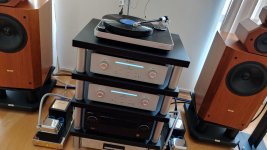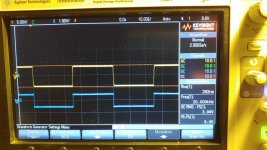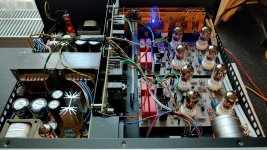I bought an original SuperReg from VacuumState about a year ago, and it actually has a little bulb instead of an LED, To the one not getting any response from them: I have dealt with them a few times, and every time things took a very long time. And for the price the quality were quite low. Sorry to say it.
Look at this circuit (#1) even if it is not the same amp but the same output stage (Mosfet instead of tube).
A little bit of history. It may not seem like it, but the RTP5 circuit is actually earlier than the RTP3C. Yes, the phono stage is effectively the same (some very slight variations in values that you can see).
See the attachment below, which is one-half of the FVP5 circuit. It looks like half of the RTP5 and it is, except the triode gain stage is grounded (no current source, as is used in the RTP5 circuit)
What I have actually done is changed the RTP5 into the FVP5 preamps made in Australia and they are that closely related.
The "FVP5" line stage as single-ended is in fact the circuit Allen and I decided upon in 1997 for the FVP. I remember the year because it was the time when he turned up in Australia and had told me he had just turned fifty. I had suggested the circuit for the FVP (later the SVP) rather than use SRRP and he had agreed that the "Super-Linear Cathode Follower" was WAY better.
He then said that doubling up and add the current source to the input would make it the line stage for the RTP preamp and he understood that I had come to that conclusion as well. It was so obvious the way to go with the RTP line stage.
That is the circuit became the RTP5.
Note the 47K resistor encircled in red, which was Allen's solution to deal with the high gate capacitance of the MOSFET. The use of IRF710 here is that it has lower gate capacitance than what we used initially IRF820.
The RTP3C adds complexity to the line stage, the use of a cascoded gain stage and even better/complex current source for the "Super-Linear Cathode Follower" and is all Allen design decisions. Tube number goes up to ten. I have built about a dozen RTP5's and not a single RTP3C or similar. Full disclosure.
Cheers, Joe
PS: Note the FVP and SVP variants are all inverting. This is of course avoided in the RTP variants.
.
Attachments
Last edited:
My photos disappeared from post 542. They didn't make the forum jump to hyperspace. I thought I would replace them.
Cheers; Glenn
Great build, Glenn!!
Thank you bequerel
I should ask Thomas what tubes the Vacuum State preamps ship with. I started with used tubes then switched to new JJs. The JJs began to fail so I looked for something better. Ended up with nos Siemens Halske (early 70's) in matched pairs. It took a while to find them all but worth it. Beautifully musical. Detailed. Well worth selling a body part.
Cheers; Glenn
I should ask Thomas what tubes the Vacuum State preamps ship with. I started with used tubes then switched to new JJs. The JJs began to fail so I looked for something better. Ended up with nos Siemens Halske (early 70's) in matched pairs. It took a while to find them all but worth it. Beautifully musical. Detailed. Well worth selling a body part.
Cheers; Glenn
With ECC88 (or equivalents) we use EH for nearly 15 years now, never had a DOA, and only a very few dying prematurely. So far no complaints of those going bad quickly in the field, at least none I know of. Sure, they don't last forever and good(!) NOS stuff sounds better, but as a manufacturer you need available and reliable stuff.
I have always used EH 6922s in my RTP3C, on Allen's recommendation, and I'm on my second set now (mine is about fifteen years old). The only thing you need to watch out for is that, for some strange reason, the EH versions I have have a higher heater current than what is specified in the data sheet: I found that at 6.3V they passed 350-360mA, where the Sylvania 6922 I use in my SVP pass close to the nominal 300mA. This is only an issue if you are using Allen's preferred current regulation, as the EH valves are significantly under-voltage at 300mA. After I discovered this I changed to voltage regulation for the heaters.
I started a thread on this forum about it: someone has posted since that the same appears to hold for Sovtek valves (from the same factory as EH, of course).
Alex
I started a thread on this forum about it: someone has posted since that the same appears to hold for Sovtek valves (from the same factory as EH, of course).
Alex
Hi Thomas and Alex,
I thought that Allen had switched over to 7DJ8 ( PCC88 ) tubes because they work better with current sourced heaters, see here:
"The point was to reduce imbalance in a series string" - Allen Wright - Tube DIY Asylum
But when using ECC88 types of tubes in combination with current sourced heaters I think the only thing needed is to make the CCS adjustable and then set the current for each tube to reach the required correct heater voltage. Maybe not so convenient but it can be done as vtr already mentioned here on Page 24.
Günter
I thought that Allen had switched over to 7DJ8 ( PCC88 ) tubes because they work better with current sourced heaters, see here:
"The point was to reduce imbalance in a series string" - Allen Wright - Tube DIY Asylum
But when using ECC88 types of tubes in combination with current sourced heaters I think the only thing needed is to make the CCS adjustable and then set the current for each tube to reach the required correct heater voltage. Maybe not so convenient but it can be done as vtr already mentioned here on Page 24.
Günter
Last edited:
In the current production units we use voltage regulation (with softstart) in the RTP3E and SVP2. Therefor it's ECC88/6DJ8/6922, which is specified to be fed with 6.3V resulting in a 330-365mA current draw. For the hardwired units with the current regulators it's the PCC88/7DJ8, which is specified to draw 300mA resulting in about 7.3V. When you put 6922s in a 3C or D (with 2 exceptions that are already PCB based) the tubes will run too cold.
For PCC88s we don't have a standard brand, here we rely on the expertise and offer of our tube supplier. And I never made a secret out of this: That's BTB in Nürnberg.
For PCC88s we don't have a standard brand, here we rely on the expertise and offer of our tube supplier. And I never made a secret out of this: That's BTB in Nürnberg.
Last edited:
For PCC88s we don't have a standard brand, here we rely on the expertise and offer of our tube supplier. And I never made a secret out of this: That's BTB in Nürnberg.
Yes, I use BTB too, originally on Allen's recommendation. I have nothing but praise for their service, though I have no experience buying since Brexit.
Alex
Thank you for answering my question. Reliability was my main concern along with which brand could supply such reliability.With ECC88 (or equivalents) we use EH for nearly 15 years now, never had a DOA, and only a very few dying prematurely. So far no complaints of those going bad quickly in the field, at least none I know of. Sure, they don't last forever and good(!) NOS stuff sounds better, but as a manufacturer you need available and reliable stuff.
Cheers; Glenn
hi all,
so finally here is my build - aka RTP3C, line stage only, with IRF820 at output stage bootstrap instead 5-th tube.
the case is some Aliexpress Reisong/marantz7 model, I had to bought 2pcs at past, so I have used its power supplies and input switching PCBs.
good news is, after assembly it still keeps about 1MHz bandwith - it sounds really nice.
> thanx Allen <



so finally here is my build - aka RTP3C, line stage only, with IRF820 at output stage bootstrap instead 5-th tube.
the case is some Aliexpress Reisong/marantz7 model, I had to bought 2pcs at past, so I have used its power supplies and input switching PCBs.
good news is, after assembly it still keeps about 1MHz bandwith - it sounds really nice.
> thanx Allen <
hi all,
so finally here is my build - aka RTP3C, line stage only, with IRF820 at output stage bootstrap instead 5-th tube.
the case is some Aliexpress Reisong/marantz7 model, I had to bought 2pcs at past, so I have used its power supplies and input switching PCBs.
good news is, after assembly it still keeps about 1MHz bandwith - it sounds really nice.
> thanx Allen <
Images seem to have disappeared?
- Home
- Amplifiers
- Tubes / Valves
- Vacuum State RTP3C

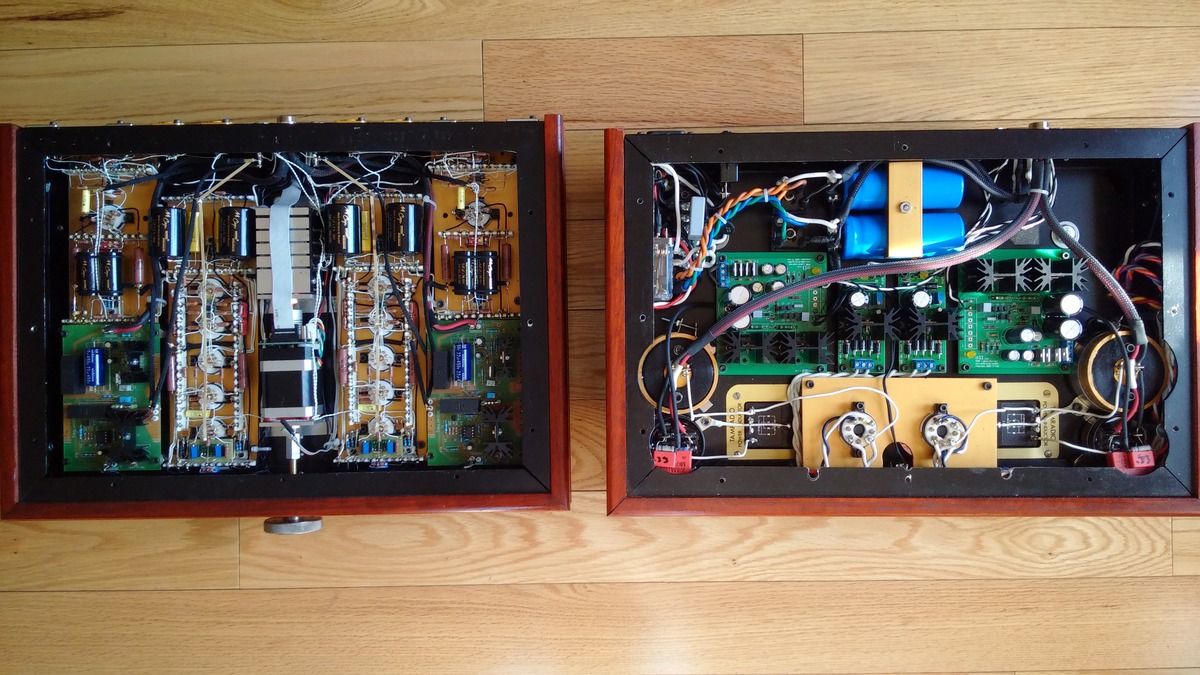
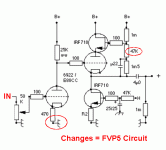
![IMG_0345[1].jpg](/community/data/attachments/868/868149-9665dc9dcb2cac1564212151e83f3cd9.jpg)
![IMG_0344[1].jpg](/community/data/attachments/868/868161-f8aaa19ef5e204a90969641bdd6f4ea5.jpg)
